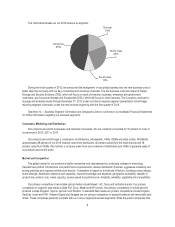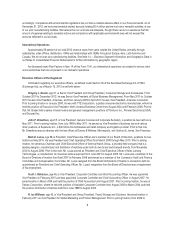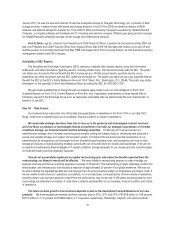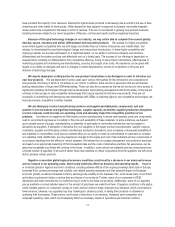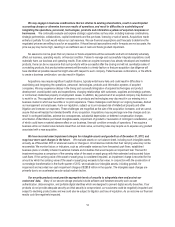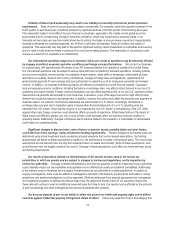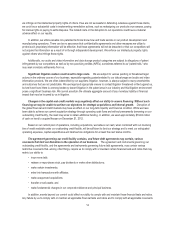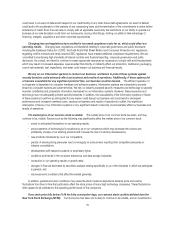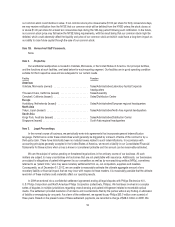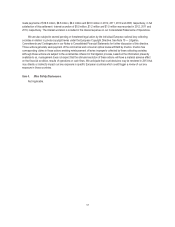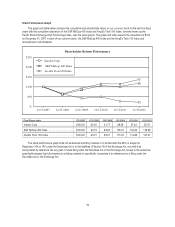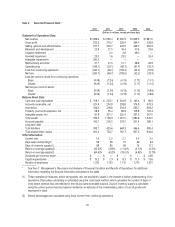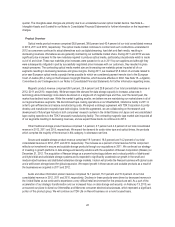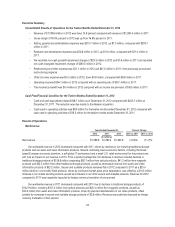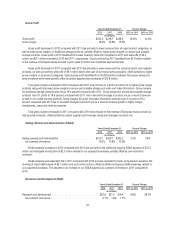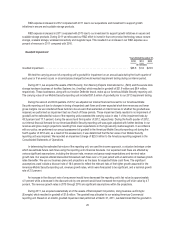Memorex 2012 Annual Report Download - page 18
Download and view the complete annual report
Please find page 18 of the 2012 Memorex annual report below. You can navigate through the pages in the report by either clicking on the pages listed below, or by using the keyword search tool below to find specific information within the annual report.could result in an event of default with respect to our credit facility or any other future debt agreements. An event of default
could lead to the acceleration of the maturity of any outstanding loans and the termination of the commitments to make further
extensions of credit. Even if we are able to comply with all applicable covenants, the restrictions on our ability to operate our
business at our sole discretion could harm our business by, among other things, limiting our ability to take advantage of
financing, mergers, acquisitions and other corporate opportunities.
Changing laws and regulations have resulted in increased compliance costs for us, which could affect our
operating results. Changing laws, regulations and standards relating to corporate governance and public disclosure,
including the Sarbanes-Oxley Act of 2002, the Dodd-Frank Wall Street Reform and Consumer Protection Act, regulations
regarding conflict minerals and newly enacted SEC regulations have created additional compliance requirements. We are
committed to maintaining high standards of internal controls over financial reporting, corporate governance and public
disclosure. As a result, we intend to continue to invest appropriate resources as necessary to comply with evolving standards
which may result in increased expenses. Laws enacted that directly or indirectly affect our production, distribution, packaging,
cost of raw materials, fuel, ingredients, and water could impact our business and financial results.
We rely on our information systems to conduct our business, and failure to protect these systems against
security breaches could adversely affect our business and results of operations. Additionally, if these systems fail
or become unavailable for any significant period of time, our business could be harmed. The efficient operation of
our business is dependent on computer hardware and software systems. Information systems are vulnerable to security
breach by computer hackers and cyber terrorists. We rely on industry accepted security measures and technology to securely
maintain confidential and proprietary information maintained on our information systems. However, these measures and
technology may not adequately prevent security breaches. In addition, the unavailability of the information systems or failure
of these systems to perform as anticipated for any reason could disrupt our business and could result in decreased
performance and increased overhead costs, causing our business and results of operations to suffer. Any significant
interruption or failure of our information systems or any significant breach of security could adversely affect our business and
results of operations.
The market price of our common stock is volatile. The market price of our common stock has been, and may
continue to be, volatile. Factors such as the following may significantly affect the market price of our common stock:
• actual or anticipated fluctuations in our operating results;
• announcements of technological innovations by us or our competitors which may decrease the volume and
profitability of sales of our existing products and increase the risk of inventory obsolescence;
• new products introduced by us or our competitors;
• periods of severe pricing pressures due to oversupply or price erosion resulting from competitive pressures or
industry consolidation;
• developments with respect to patents or proprietary rights;
• conditions and trends in the consumer electronics and data storage industries;
• contraction in our operating results or growth rates;
• changes in financial estimates by securities analysts relating specifically to us or the industries in which we participate
in general; and
• macroeconomic conditions that affect the market generally.
In addition, general economic conditions may cause the stock market to experience extreme price and volume
fluctuations from time to time that particularly affect the stock prices of many high technology companies. These fluctuations
often appear to be unrelated to the operating performance of the companies.
If our stock price falls below $1.00 for thirty consecutive days, our common stock could be delisted from the
New York Stock Exchange (NYSE). Our stock price has been and is likely to continue to be volatile, and an investment in
15



